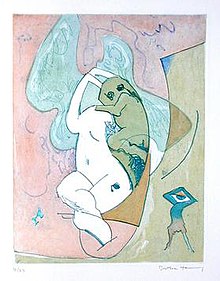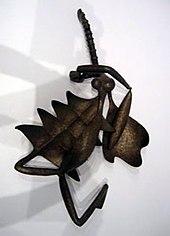There is no clear consensus about the end, or if there was an end, to
the Surrealist movement. Some art historians suggest that World War II
effectively disbanded the movement. However, art historian
Sarane Alexandrian
(1970) states, "the death of André Breton in 1966 marked the end of
Surrealism as an organized movement." There have also been attempts to
tie the obituary of the movement to the 1989 death of Salvador Dalí
[citation needed].
In the 1960s, the artists and writers associated with the
Situationist International were closely associated with Surrealism. While
Guy Debord was critical of and distanced himself from Surrealism, others, such as
Asger Jorn, were explicitly using Surrealist techniques and methods.
The events of May 1968
in France included a number of Surrealist ideas, and among the slogans
the students spray-painted on the walls of the Sorbonne were familiar
Surrealist ones.
Joan Miró would commemorate this in a painting titled
May 1968. There were also groups who associated with both currents and were more attached to Surrealism, such as the
Revolutionary Surrealist Group.
In Europe and all over the world since the 1960s, artists have
combined Surrealism with what is believed to be a classical 16th century
technique called
mischtechnik, a kind of mix of
egg tempera and oil paint rediscovered by
Ernst Fuchs, a contemporary of Dalí, and now practiced and taught by many followers, including
Robert Venosa and
Chris Mars. The former curator of the
San Francisco Museum of Modern Art,
Michael Bell, has called this style "veristic Surrealism", which
depicts with meticulous clarity and great detail a world analogous to
the dream world. Other
tempera artists, such as
Robert Vickrey, regularly depict Surreal imagery.
During the 1980s, behind the
Iron Curtain, Surrealism again entered into politics with an underground artistic opposition movement known as the
Orange Alternative. The Orange Alternative was created in 1981 by
Waldemar Fydrych (alias 'Major'), a graduate of history and art history at the University of
Wrocław.
They used Surrealist symbolism and terminology in their large scale
happenings organized in the major Polish cities during the
Jaruzelski
regime, and painted Surrealist graffiti on spots covering up
anti-regime slogans. Major himself was the author of a "Manifesto of
Socialist Surrealism". In this manifesto, he stated that the socialist
(communist) system had become so Surrealistic that it could be seen as
an expression of art itself.
Surrealistic art also remains popular with museum patrons. The
Guggenheim Museum in New York City held an exhibit,
Two Private Eyes, in 1999, and in 2001
Tate Modern held an exhibition of Surrealist art that attracted over 170,000 visitors. In 2002 the
Met in New York City held a show,
Desire Unbound, and the
Centre Georges Pompidou in Paris a show called
La Révolution surréaliste.
Surrealists groups and literary publications have continued to be
active up to the present day, with groups such as the Czech Surrealist
Group, Stockholm Surrealist Group, and the Chicago Surrealist Group. Jan
Švankmajer of the Czech group continues to make films and experiment
with objects.
Impact of Surrealism
While Surrealism is typically associated with the arts, it has been said
[by whom?]
to transcend them; Surrealism has had an impact in many other fields.
In this sense, Surrealism does not specifically refer only to
self-identified "Surrealists", or those sanctioned by Breton, rather, it
refers to a range of creative acts of revolt and efforts to liberate
imagination.
[citation needed] In addition to Surrealist ideas that are grounded in the ideas of
Hegel,
Marx and
Freud, Surrealism is seen by its advocates as being inherently dynamic and as
dialectical in its thought.
[clarification needed]
Other sources used by Surrealism epigons
Surrealists have also drawn on sources as seemingly diverse as
Clark Ashton Smith,
Montague Summers,
Horace Walpole,
Fantômas,
The Residents,
Bugs Bunny,
comic strips, the obscure poet
Samuel Greenberg and the
hobo writer and humourist
T-Bone Slim. One might say that Surrealist strands may be found in movements such as
Free Jazz (
Don Cherry,
Sun Ra,
Cecil Taylor
etc.) and even in the daily lives of people in confrontation with
limiting social conditions. Thought of as the effort of humanity to
liberate imagination as an act of insurrection against society,
Surrealism finds precedents in the
alchemists, possibly
Dante,
Hieronymus Bosch,
[42][43] Marquis de Sade,
[42] Charles Fourier,
Comte de Lautreamont and
Arthur Rimbaud.
[44][45]
1960s riots
Surrealists
believe that non-Western cultures also provide a continued source of
inspiration for Surrealist activity because some may strike up a better
balance between instrumental reason and imagination in flight than
Western culture.
[citation needed]
Surrealism has had an identifiable impact on radical and revolutionary
politics, both directly — as in some Surrealists joining or allying
themselves with radical political groups, movements and parties — and
indirectly — through the way in which Surrealists emphasize the intimate
link between freeing imagination and the mind, and liberation from
repressive and archaic social structures. This was especially visible in
the
New Left of the 1960s and 1970s and the
French revolt of May 1968, whose slogan "All power to the imagination" rose directly from French Surrealist thought and practice.
Postmodernism and popular culture
Many
significant literary movements in the later half of the 20th century
were directly or indirectly influenced by Surrealism. This period is
known as the
Postmodern era; though there's no widely agreed upon central definition of
Postmodernism, many themes and techniques commonly identified as Postmodern are nearly identical to Surrealism.
Many writers from and associated with the
Beat Generation were influenced greatly by Surrealists.
Philip Lamantia[46] and
Ted Joans[47]
are often categorized as both Beat and Surrealist writers. Many other
Beat writers show significant evidence of Surrealist influence. A few
examples include
Bob Kaufman,
[48][49] Gregory Corso,
[50] Allen Ginsberg,
[51] and
Lawrence Ferlinghetti.
[52] Artaud in particular was very influential to many of the Beats, but especially Ginsberg and
Carl Solomon.
[53] Ginsberg cites Artaud's "Van Gogh -- The Man Suicided by Society" as a direct influence on "
Howl",
[54] along with Apollinaire's "Zone",
[55] García Lorca's "Ode to Walt Whitman",
[56] and Schwitters' "Priimiititiii".
[57] The structure of Breton's "Free Union" had a significant influence on Ginsberg's "Kaddish".
[58]
In Paris, Ginsberg and Corso met their heroes Tristan Tzara, Marcel
Duchamp, Man Ray, and Benjamin Péret, and to show their admiration
Ginsberg kissed Duchamp's feet and Corso cut off Duchamp's tie.
[59]
William S. Burroughs, a core member of the Beat Generation and a postmodern novelist, developed the
cut-up technique with former surrealist
Brion Gysin—in
which chance is used to dictate the composition of a text from words
cut out of other sources—referring to it as the "Surrealist Lark" and
recognizing its debt to the techniques of Tristan Tzara.
[60]
Postmodern novelist
Thomas Pynchon,
who was also influenced by Beat fiction, experimented since the 1960s
with the surrealist idea of startling juxtapositions; commenting on the
"necessity of managing this procedure with some degree of care and
skill", he added that "any old combination of details will not do. Spike
Jones, Jr., whose father's orchestral recordings had a deep and
indelible effect on me as a child, said once in an interview, 'One of
the things that people don't realize about Dad's kind of music is, when
you replace a C-sharp with a gunshot, it has to be a C-sharp gunshot or
it sounds awful.'"
[8]
Many other postmodern fiction writers have been directly influenced by Surrealism.
Paul Auster, for example, has translated Surrealist poetry and said the Surrealists were "a real discovery" for him.
[61] Salman Rushdie, when called a Magical Realist, said he saw his work instead "allied to surrealism".
[62][63] For the work of other postmodernists, such as
Donald Barthelme[64] and
Robert Coover,
[65] a broad comparison to Surrealism is common.
Magic realism,
a popular technique among novelists of the latter half of the 20th
century especially among Latin American writers, has some obvious
similarities to Surrealism with its juxtaposition of the normal and the
dream-like, as in the work of
Gabriel García Márquez.
[66] Carlos Fuentes
was inspired by the revolutionary voice in Surrealist poetry and points
to inspiration Breton and Artaud found in Fuentes' homeland, Mexico.
[67]
Though Surrealism was a direct influence on Magic Realism in its early
stages, many Magic Realist writers and critics, such as Amaryll Chanady
[68] and S. P. Ganguly,
[69]
while acknowledging the similarities, cite the many differences
obscured by the direct comparison of Magic Realism and Surrealism such
as an interest in psychology and the artefacts of European culture they
claim is not present in Magic Realism. A prominent example of a Magic
Realist writer who points to Surrealism as an early influence is
Alejo Carpentier
who also later criticized Surrealism's delineation between real and
unreal as not representing the true South American experience.
[70][71]






